July 13 - 19, 2014: Issue 171
Landing Practice Incidents on HMS Ravager – Framed Photographs Picture
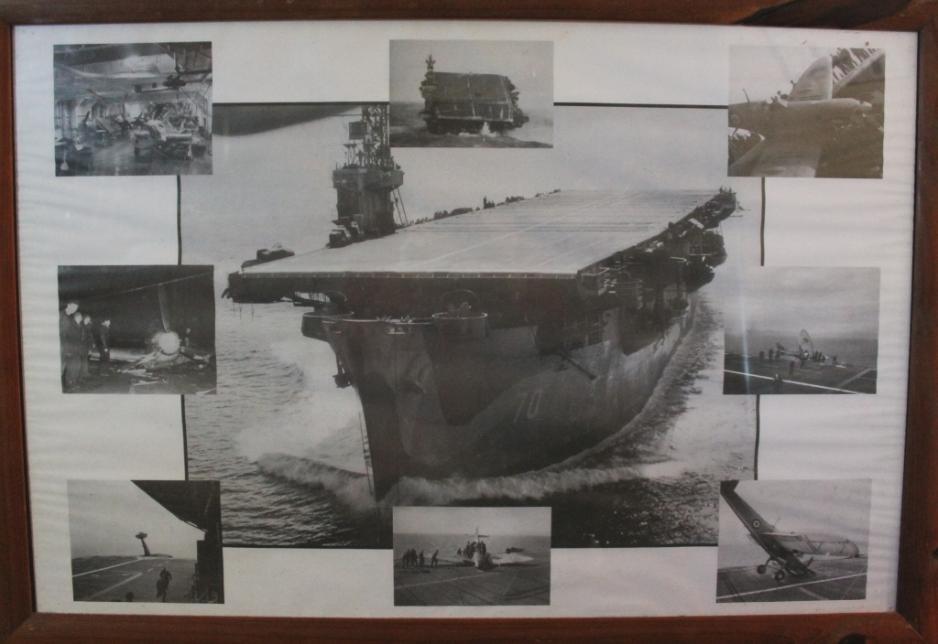
Landing Practice Incidents on HMS Ravager – Framed Photographs Picture
Men who have served in the Navy, whether the RAN or RN or the Merchant Navy during WWII make no secret of the fact that they dream of being at sea long after they come ashore permanently and most have a few if not many photographs of their time serving upon the seas. A framed series of photographs left with us a while ago seems to depict a series of mishaps of planes on an aircraft carrier and was kept, until given to us, because ‘grandfather served on that ship.’
Not much else was explained, particularly why the framed pictures feature ‘mishaps’, and the young man whose item this is, please collect if you should see this, has left the front yard a while ago now. It is quite large, at least three and a half feet by two and a half feet, and clearly meant to feature on a wall somewhere - preferably in the home of one who has a stronger claim to ownership.
An investigation showed that the ship shown is the HMS Ravager (D70), which was an Ruler class escort carrier built in the United States and operated by the Royal Navy during World War II and she was a TRACKER-Class Escort Aircraft Carrier obtained under US/UK Lend Lease Agreement in May 1942.
Ravager was initially constructed in the U.S. by Seattle-Tacoma Shipbuilding in Tacoma, laid down in April 11th, 1942 and launched july 16th of the same year. She was purchased by the U.S. Navy and was converted to an escort carrier at Commercial Iron Works, Portland, Oregon. Upon completion in 1943 she was transferred to the Royal Navy and named HMS Ravager.
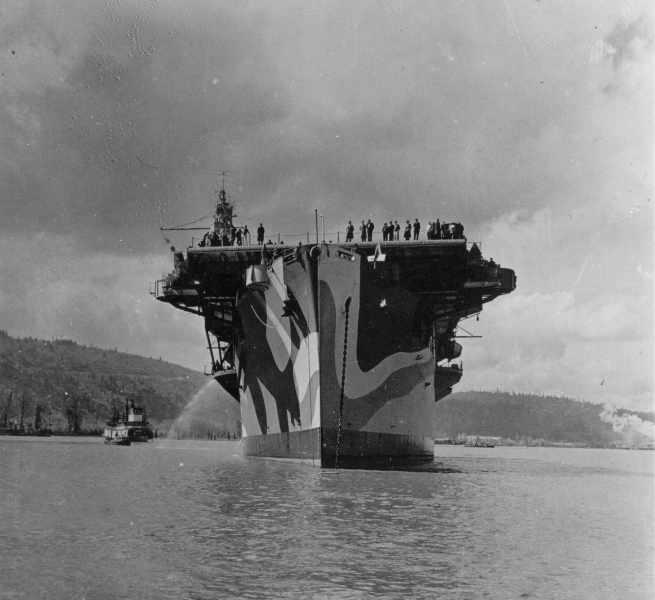
April 9th 1943 - HMS Ravager on her builders trials in the Willamette River, Oregon
Sea trails were completed off Vancouver, Canada. Leaving there in July, 1943 she sailed to the Panama Canal and embarked men and aircraft of 846 squadron US Naval air for transport to the UK.
She served in the Atlantic on convoy escort duties operating Wildcats of 835 squadron and Hellcats of 804 squadron between September and October of 1943. From the end of 1943 she was used primarily as a Deck Landing Training Carrier off the Scottish coast operating alongside HMS Argus in the Clyde.
While there a variety of training squadrons and aircraft, including Avenger, Barracuda, Corsair, Firefly, Fulmar, Hellcat, Sea Hurricane, Seafire, Spitfire, Swordfish and Hellcat, practiced landing on her deck.
Quarterly reports on Naval Aviation produced for the War Cabinet recorded the numbers of pilots who had qualified in deck landing or who had undergone refresher courses from then until the end of the war, although these unfortunately don't distinguish between the various carriers used for the role, so we can’t bring you totals for those who didn’t have a mishap.
A number of squadrons were officially based on the Ravager to carry out their training, including No.835 (Sea Hurricane) between September and November 1943, No.1833 Squadron (Corsair II) in November-December 1943, No.1834 Squadron (Corsair) in the first half of February 1944 and No.1771 Squadron (Fairey Firefly) during the summer of 1944. Other pilots trained with No.761 Squadron, the advanced training squadron of the Fleet Fighter School.(1).
In February 1946 she was returned to the US Navy and sold for civilian use in July 1947 to Willaim B St John, being renamed the SS Robin Trent and later the Trent. She was scrapped at Kaohsiung, Taiwan in 1973.
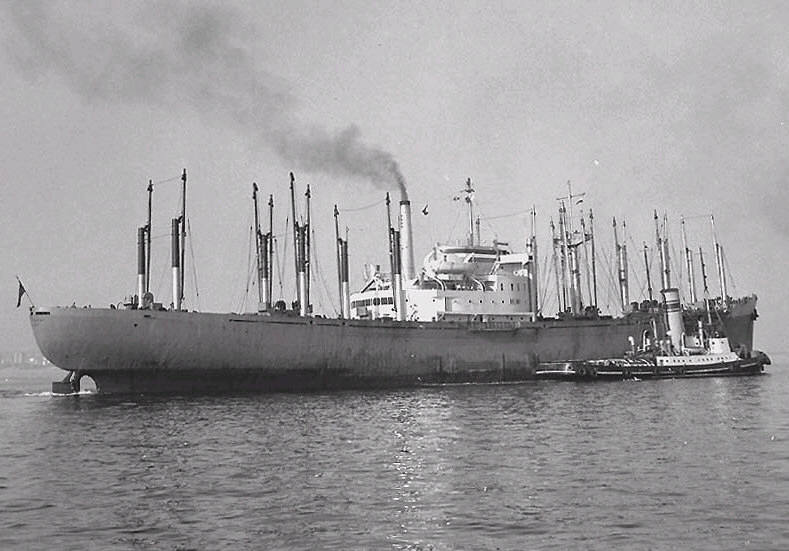
Ex-HMS Ravager, rebuilt and renamed Robin Trent, US flag, 1948. Photo courtesy Gerhard Mueller-Debus
Commands listed for HMS Ravager (D 70)
(incomplete)
Commander From To
1 A/Capt. Alec Anderson Murray, RN 28 Dec 1942 16 May 1944
2 A/Capt. George Vivian Barnett Faulkner, RN 16 May 1944 23 Oct 1945
3 Capt. Charles Richard Vernon Pugh, RN 23 Oct 1945 ???
Design and description
These ships were all larger and had a greater aircraft capacity than all the preceding American built escort carriers. They were also all laid down as escort carriers and not converted merchant ships. All the ships had a complement of 646 men and an overall length of 492 feet 3 inches (150.0 m), a beam of 69 feet 6 inches (21.2 m) and a draught of 25 ft 6 in (7.8 m).[1] Propulsion was provided by one shaft, two boilers and a steam turbine giving 9,350 shaft horsepower (SHP), which could propel the ship at 16.5 knots (30.6 km/h; 19.0 mph).
Aircraft facilities were a small combined bridge–flight control on the starboard side, two aircraft lifts 43 feet (13.1 m) by 34 feet (10.4 m), one aircraft catapult and nine arrestor wires. Aircraft could be housed in the 260 feet (79.2 m) by 62 feet (18.9 m) hangar below the flight deck. Armament comprised: two 4 inch Dual Purposeguns in single mounts, sixteen 40 mm Bofors anti-aircraft guns in twin mounts and twenty 20 mm Oerlikon anti-aircraft cannons in single mounts. They had a maximum aircraft capacity of twenty-four aircraft which could be a mixture of Grumman Martlet, Vought F4U Corsair or Hawker Sea Hurricane fighter aircraft and Fairey Swordfish or Grumman Avenger anti-submarine aircraft. (2).
General characteristics
Class & type: Bogue class escort carrier
Displacement: 14,630 tons (full load)
Length: 465 ft (142 m)
Beam: 69 ft (21 m)
Draught: 23 ft (7.0 m)
Propulsion: Steam turbines, 8,500 shp (6.3 MW)
Speed: 18 knots (33 km/h)
Complement: 646 officers and enlisted
Armament: 2 × 4 in (102 mm) guns
15 × 20 mm guns AA
Aircraft carried: 20
Service record
Operations: Battle of the Atlantic (1943-44)
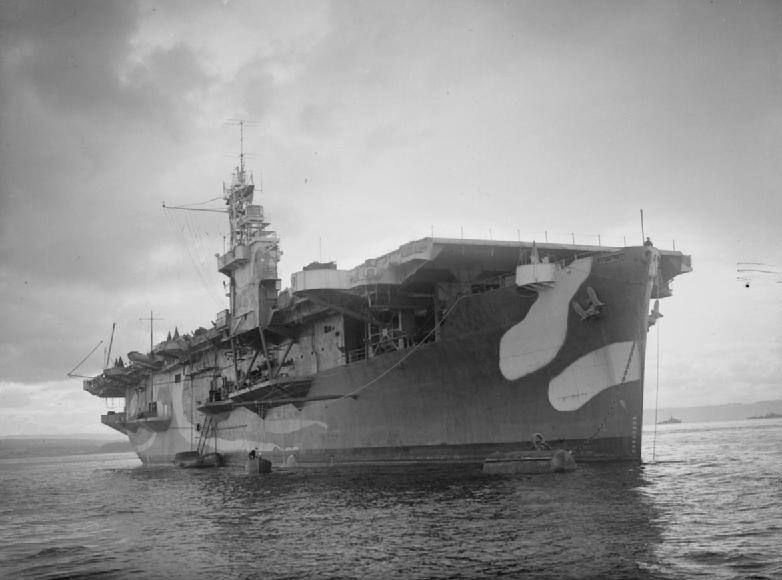
HMS Ravager moored at Greenock. by Beadell, S J (Lt) Royal Navy official photographer - This is photograph A 18728 from the collections of the Imperial War Museums (collection no. 4700-01)
Greenock (Scottish Gaelic: Grianaig) is a town and administrative centre in the Inverclyde council area in Scotland and a former burgh within the historic county of Renfrewshire, located in the west central Lowlands of Scotland. It forms part of a contiguous urban area with Gourock to the west and Port Glasgow to the east.
Greenock suffered badly during the Second World War and its anchorage at the Tail of the Bank became the base for the Home Fleet as well as the main assembly point for Atlantic convoys. On 30 April 1940 the French Vauquelin class destroyer Maillé Brézé blew up off Greenock with heavy loss of life following an accident involving two of her own torpedoes. Although this disaster occurred before the Free French Naval Forces were established, many people tend to regard the Cross of Lorraine on Lyle Hill as a memorial to the loss of the Maillé Brézé as well as to the later losses of the Free French naval vessels which sailed from the town. On the nights of 6 May and 7 May 1941 around 300 Luftwaffe aircraft attacked the town in the Greenock Blitz.
The George Medal was awarded to three local firemen: Firemaster A.S. Pratten, Sub-Station Officer William Neill and Fireman James Berry who entered a burning building and at great personal risk managed to control a blaze which threatened to destroy a quantity of material essential to the war effort.
The Ruler class of escort aircraft carriers served with the Royal Navy during the Second World War. All twenty-eight ships were built by the Seattle-Tacoma Shipbuilding Corporation in the United States and supplied under Lend-Lease; They were the most numerous single class of aircraft carriers in service with the Royal Navy. As built they were intended for three types of operations, "Assault" or strike, convoy escort, or aircraft ferry.
These ships were all larger and had greater aircraft capacity than all preceding American built escort carriers. They were laid down as escort carriers and were not converted merchant ships. All the ships had a complement of 646 men and an overall length of 492 feet 3 inches (150.0 m), a beam of 69 feet 6 inches (21.2 m) and a draught of 25 ft 6 in (7.8 m). Propulsion was provided by one shaft, two boilers and a steam turbine giving 9,350 shaft horsepower (SHP), which could propel the ship at 16.5 knots (30.6 km/h; 19.0 mph).
Aircraft facilities were a small combined bridge–flight control on the starboard side, two aircraft lifts 43 feet (13.1 m) by 34 feet (10.4 m), one aircraft catapult and nine arrestor wires.
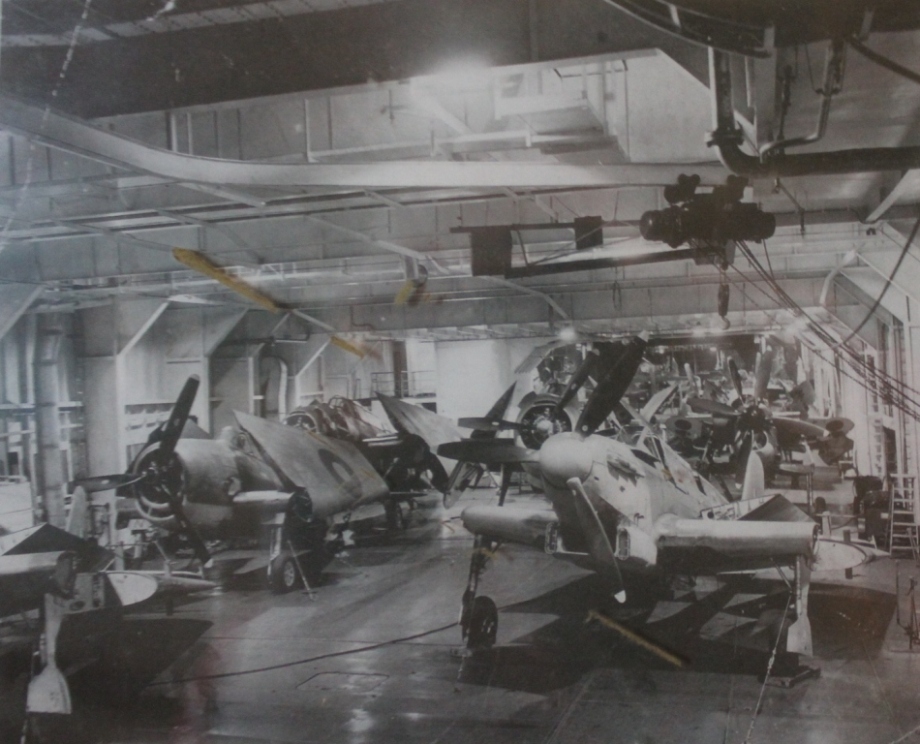
Aircraft could be housed in the 260 feet (79.2 m) by 62 feet (18.9 m) hangar below the flight deck. Armament comprised: two 4 inch Dual Purposeguns in single mounts, sixteen 40 mm Bofors anti-aircraft guns in twin mounts and twenty 20 mm Oerlikon anti-aircraft cannons in single mounts. They had a maximum aircraft capacity of twenty-four aircraft which could be a mixture of Grumman Martlet, Vought F4U Corsair or Hawker Sea Hurricane fighter aircraft and Fairey Swordfish torpedo bomber or Grumman Avenger anti-submarine aircraft. (3).
Some of the Mishaps
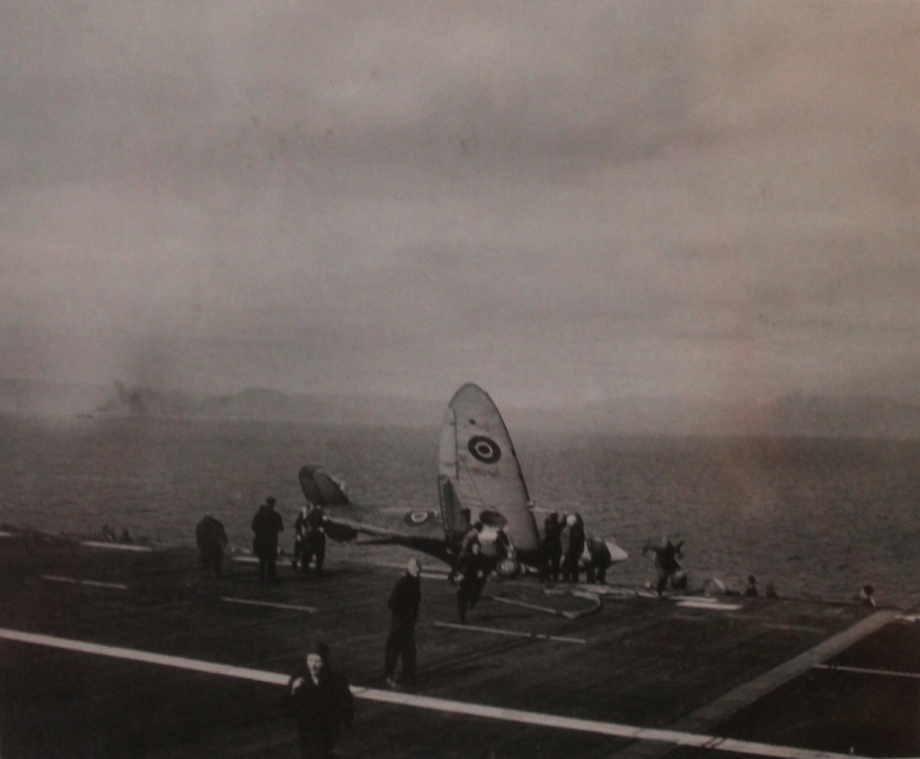

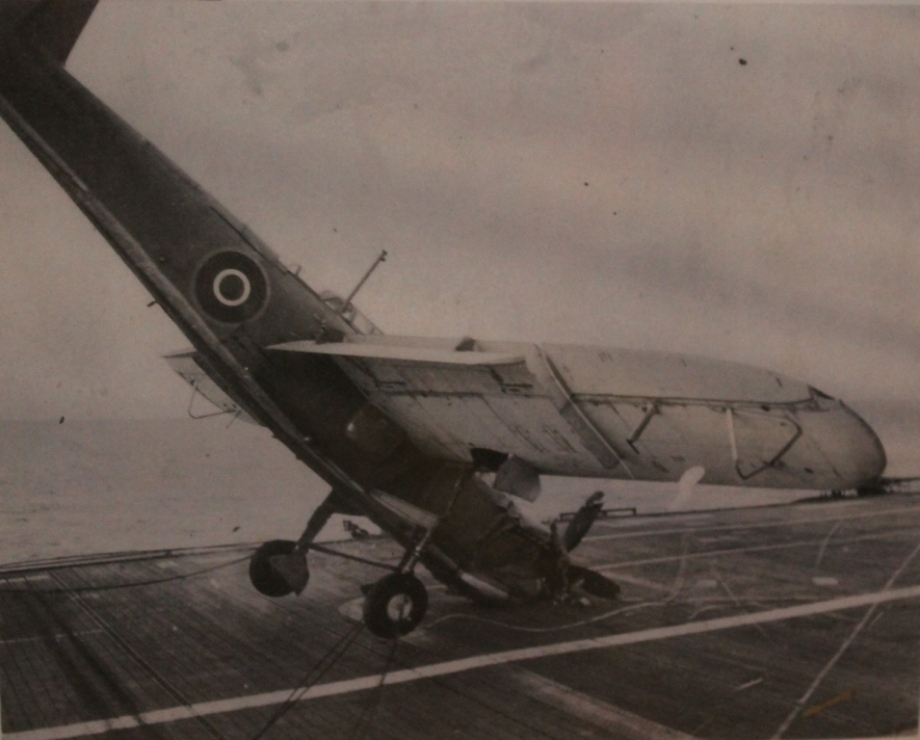
Barracuda II LS 691 of 768 Squadron catches barrier rope and falls nose first onto deck of HMS Ravager – Scottish coast, July 12th, 1944
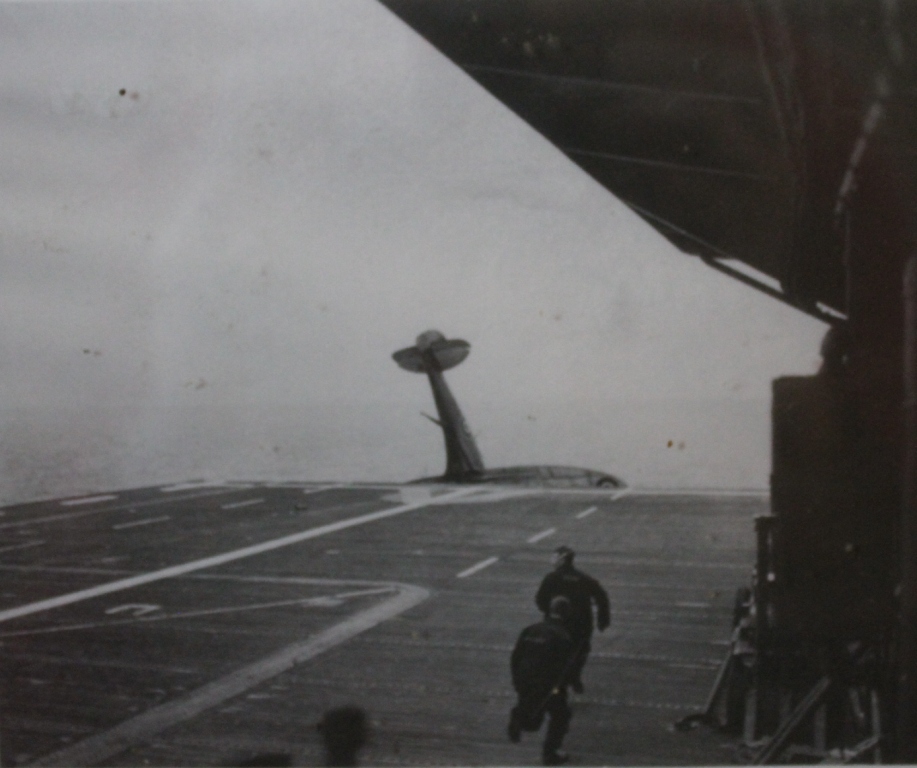
August 10th, 1944, Sgt.Lt.’s J. A. Marriott clears both barriers and stops in bow gun mounts in Spitfire Vb BL818 of 768 Squadron.
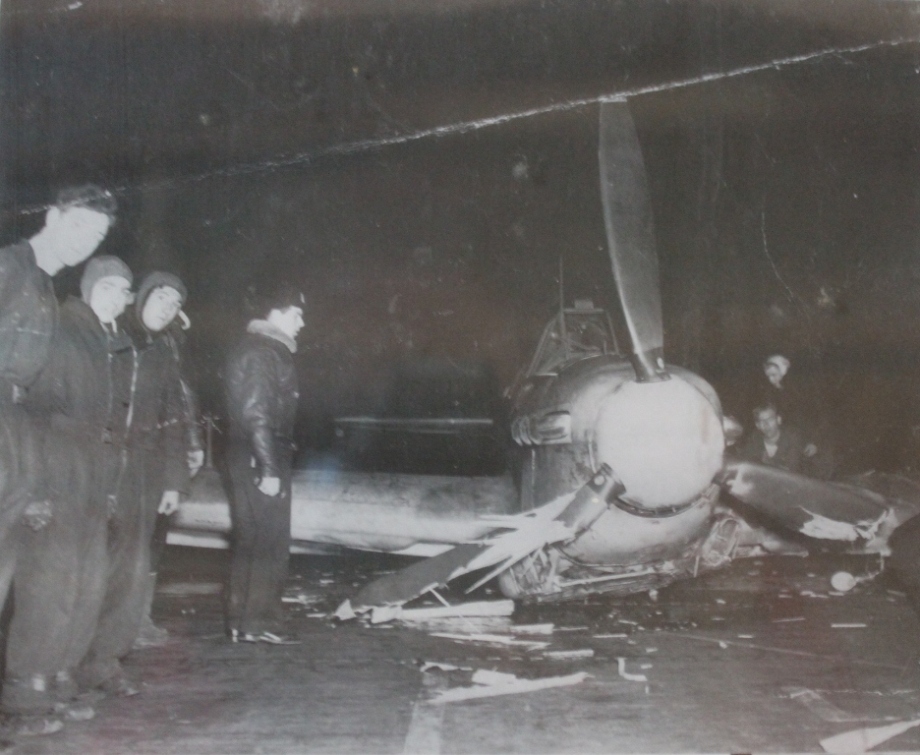
Fulmar DR726 of 768 Squadron, flown by S/Lt. I. C. Faulconer – night deck landing February 23rd, 1944
References
1. HMS Ravager on History of War website: http://www.historyofwar.org/articles/weapons_HMS_Ravager.html
2. HMS Ravager (D70). (2013, March 31). In Wikipedia, The Free Encyclopedia. Retrieved from http://en.wikipedia.org/w/index.php?title=HMS_Ravager_(D70)&oldid=547976000
3. Ruler-class escort carrier. (2013, October 7). In Wikipedia, The Free Encyclopedia. Retrieved from http://en.wikipedia.org/w/index.php?title=Ruler-class_escort_carrier&oldid=576079998
Verification of what these images depict retrieved from: http://www.royalnavyresearcharchive.org.uk/ESCORT/Galleries/RAVAGER_Gllery_2.htm
Greenock Blitz. (2014, April 29). In Wikipedia, The Free Encyclopedia. Retrieved from http://en.wikipedia.org/w/index.php?title=Greenock_Blitz&oldid=606404896
1. HMS Ravager on History of War website: http://www.historyofwar.org/articles/weapons_HMS_Ravager.html
2. HMS Ravager (D70). (2013, March 31). In Wikipedia, The Free Encyclopedia. Retrieved from http://en.wikipedia.org/w/index.php?title=HMS_Ravager_(D70)&oldid=547976000
3. Ruler-class escort carrier. (2013, October 7). In Wikipedia, The Free Encyclopedia. Retrieved from http://en.wikipedia.org/w/index.php?title=Ruler-class_escort_carrier&oldid=576079998
Verification of what these images depict retrieved from: http://www.royalnavyresearcharchive.org.uk/ESCORT/Galleries/RAVAGER_Gllery_2.htm
Greenock Blitz. (2014, April 29). In Wikipedia, The Free Encyclopedia. Retrieved from http://en.wikipedia.org/w/index.php?title=Greenock_Blitz&oldid=606404896
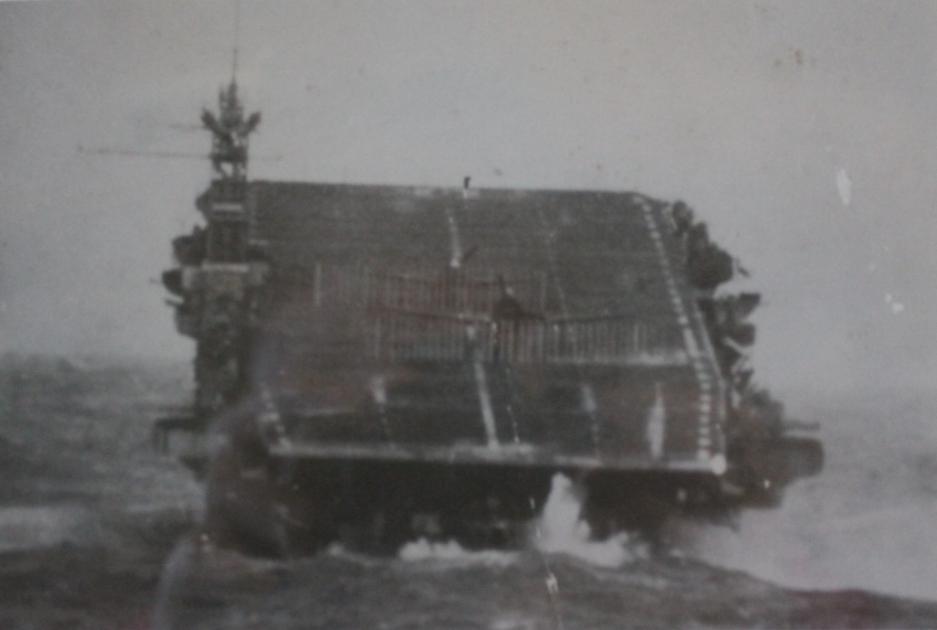
MS Ravager during a good swell
TRACKER-Class Escort Aircraft Carrier obtained under US/UK Lend Lease Agreement in May 1942. The ship was under construction by Seattle-Tacoma Shipbuilding Corporation at Seattle under the USN defence programme for conversion of C3 mercantile hulls into auxiliary aircraft carriers (CVE) for escort duties. She was transferred to the RN as a replacement for an earlier ship (CVE30) to be named HMS CHARGER but which had been retained by the US Navy for training of RN pilots renamed USS CHARGER. This replacement had been laid down on 11th April 1942 and on transfer was intended to become HMS CHARGER (ii) but the name was changed to HMS RAVAGER when she was launched on 16 July 1942. Fitting Out was completed at Portland, Oregon by the Willamette Iron and Steel Corporation on 25th April 1943. She was fitted with British radar outfits.
Battle Honours
ATLANTIC 1943
Heraldic Data
Badge: On a Field Barry wavy of ten white and blue a torch erect Black inflamed Proper in front of two swords in saltire also proper pommels and hilts gold.
(Note: Badge approved after WW2.)
Motto
'Ruthless unto Victory'
Details of War Service
1943
April Contractors trials
25th Commissioned for Royal Navy service as HMS RAVAGER.
26th Build completion and commenced sea trials.
May Completed Sea trials..
25th Took passage to Norfolk, Va via Panama Canal.
July Passage from Panama
2nd Embarked 121 AVENGER aircraft at Norfolk for transport to UK
13th Arrived at New York
15th Took passage from New York Convoy HX248 with call at Halifax
27th Disembarked aircraft after detaching from convoy.
28th Deployed at Greenock for use as a Deck Landing Training Carrier
August Deployed in Irish Sea and Clyde areas for training duties,
to
October
November Training duties in continuation
29th Sustained damage in collision with HM Escort Aircraft PRETORIA CASTLE in Clyde.
(Note: HMS PRETORIA CASTLE was also deployed in Clyde area for Deck
Landing Trials.)
Passage to Clyde for repair.
December Under repair
8th Resumed training duties.
1944
January Deck Landing training in continuation
to Nominated for deployment as a Ferry Carrier and to be refitted in Clyde shipyard.
March
April
18th Taken in hand for refit.
May
1st Resumed Deck Landing training in Clyde.
June Training duties in continuation
to
September
October Ceased training duties and embarked aircraft for transport to USA.
20th Joined outward Convoy KMF35A for passage to Gibraltar.
25th Detached from KMF29A on arrival at Gibraltar to await passage to USA.
28th Took passage to Norfolk with outward Convoy GUF15B.
November Detached from GUF15B and took passage to Norfolk, Va.
Embarked aircraft for transport to UK.
Passage to New York.
Passage to Belfast from New York
(Note Passage with routine inward convoy to Clyde to be confirmed.).
26th Deployed at Belfast
Repair arranged in London
December Passage to Thames.
1st Under repair at commercial shipyard.
26th Arrived in Rosyth to resume Deck Landing training
(Note: Time on passage suggests some form of trials in North Sea. To be confirmed.)
1945
January
4th Carried out trials of Sonar underwater detection equipment.
(Note: Trials for aircraft equipment trial to be confirmed.)
28th Sustained damage in collision with mercantile BEN LOMOND.
Passage to Rosyth.
February
11th Under repair by HM Dockyard Rosyth.
27th Resumed Deck Landing training duties.
March Under repair.
to August
P o s t W a r N o t e s
HMS RAVAGER was under repair until November 1945 and resumed Deck Landing training until the end of December that year. The ship was then Paid-off and de-stored prior to return to the US Navy. The ship was de-stored and British equipment removed before taking passage to USA with a reduced complement in. February 1946. She was formally returned on 27th February 1946.then sold for mercantile use ss ROBIN TRENT in 1948. Sold again in 1973 and renamed ss TRENT she was broken up in Taiwan and arrived at the breaker’s yard in Kaohsiung, July 1973. The RN name was re-introduced in 1947 when given to HM Landing Ship (Tank) 3505 which remained in service until being sold on 19th June 1961 for demolition.
From: http://www.naval-history.net/xGM-Chrono-05CVE-Ravager.htm
Battle Honours
ATLANTIC 1943
Heraldic Data
Badge: On a Field Barry wavy of ten white and blue a torch erect Black inflamed Proper in front of two swords in saltire also proper pommels and hilts gold.
(Note: Badge approved after WW2.)
Motto
'Ruthless unto Victory'
Details of War Service
1943
April Contractors trials
25th Commissioned for Royal Navy service as HMS RAVAGER.
26th Build completion and commenced sea trials.
May Completed Sea trials..
25th Took passage to Norfolk, Va via Panama Canal.
July Passage from Panama
2nd Embarked 121 AVENGER aircraft at Norfolk for transport to UK
13th Arrived at New York
15th Took passage from New York Convoy HX248 with call at Halifax
27th Disembarked aircraft after detaching from convoy.
28th Deployed at Greenock for use as a Deck Landing Training Carrier
August Deployed in Irish Sea and Clyde areas for training duties,
to
October
November Training duties in continuation
29th Sustained damage in collision with HM Escort Aircraft PRETORIA CASTLE in Clyde.
(Note: HMS PRETORIA CASTLE was also deployed in Clyde area for Deck
Landing Trials.)
Passage to Clyde for repair.
December Under repair
8th Resumed training duties.
1944
January Deck Landing training in continuation
to Nominated for deployment as a Ferry Carrier and to be refitted in Clyde shipyard.
March
April
18th Taken in hand for refit.
May
1st Resumed Deck Landing training in Clyde.
June Training duties in continuation
to
September
October Ceased training duties and embarked aircraft for transport to USA.
20th Joined outward Convoy KMF35A for passage to Gibraltar.
25th Detached from KMF29A on arrival at Gibraltar to await passage to USA.
28th Took passage to Norfolk with outward Convoy GUF15B.
November Detached from GUF15B and took passage to Norfolk, Va.
Embarked aircraft for transport to UK.
Passage to New York.
Passage to Belfast from New York
(Note Passage with routine inward convoy to Clyde to be confirmed.).
26th Deployed at Belfast
Repair arranged in London
December Passage to Thames.
1st Under repair at commercial shipyard.
26th Arrived in Rosyth to resume Deck Landing training
(Note: Time on passage suggests some form of trials in North Sea. To be confirmed.)
1945
January
4th Carried out trials of Sonar underwater detection equipment.
(Note: Trials for aircraft equipment trial to be confirmed.)
28th Sustained damage in collision with mercantile BEN LOMOND.
Passage to Rosyth.
February
11th Under repair by HM Dockyard Rosyth.
27th Resumed Deck Landing training duties.
March Under repair.
to August
P o s t W a r N o t e s
HMS RAVAGER was under repair until November 1945 and resumed Deck Landing training until the end of December that year. The ship was then Paid-off and de-stored prior to return to the US Navy. The ship was de-stored and British equipment removed before taking passage to USA with a reduced complement in. February 1946. She was formally returned on 27th February 1946.then sold for mercantile use ss ROBIN TRENT in 1948. Sold again in 1973 and renamed ss TRENT she was broken up in Taiwan and arrived at the breaker’s yard in Kaohsiung, July 1973. The RN name was re-introduced in 1947 when given to HM Landing Ship (Tank) 3505 which remained in service until being sold on 19th June 1961 for demolition.
From: http://www.naval-history.net/xGM-Chrono-05CVE-Ravager.htm
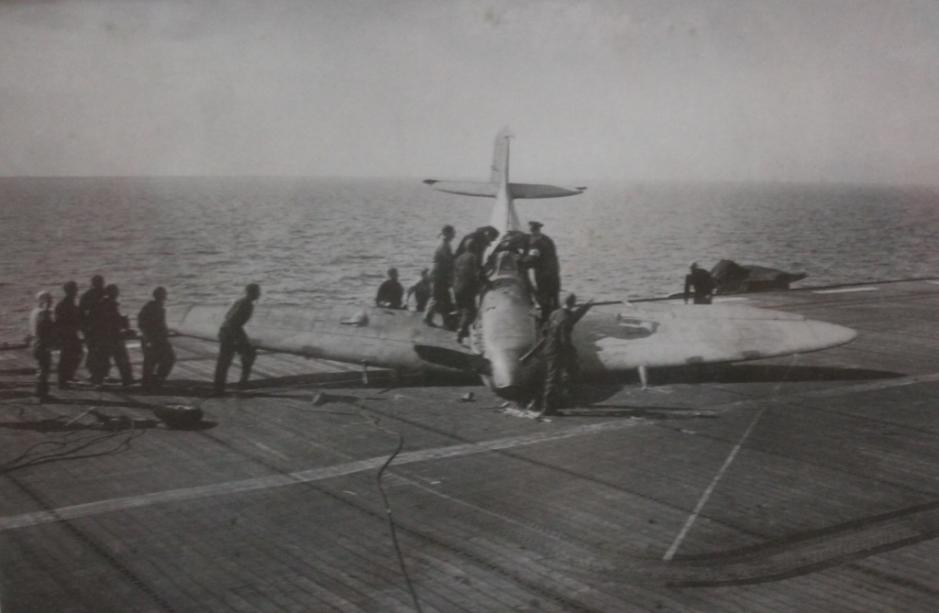
December 31st, 1943, Sub. Lt. G. C. Morris flying Spitfire P8537 of 761 Squadron in attempting a landing on deck of HMS Ravager without a tail wheel strikes barrier and came to rest face down – damaging rear fuselage